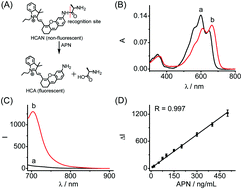Design, synthesis and application of a near-infrared fluorescent probe for in vivo imaging of aminopeptidase N†
Abstract
We have, for the first time, developed a near-infrared fluorescent probe for aminopeptidase N by combining a hemicyanine and an alanyl residue. The probe exhibits high selectivity and sensitivity with a detection limit of 0.8 ng mL−1. With the probe, aminopeptidase N has been imaged in both cells and mice in vivo, indicating a promising tool for studying the function of the enzyme.



 Please wait while we load your content...
Please wait while we load your content...